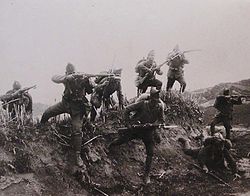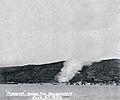| Greek Summer Offensive 1920 | |||||||
|---|---|---|---|---|---|---|---|
| Part of the Greco-Turkish War (1919–22) | |||||||
 Greek soldiers advancing. | |||||||
| |||||||
| Belligerents | |||||||
| Commanders and leaders | |||||||
| Strength | |||||||
| Casualties and losses | |||||||
| Unknown | Unknown | ||||||
The Greek Summer Offensive of 1920 was an offensive by the Greek army, assisted by British forces, to capture the southern region of the Sea of Marmara and the Aegean Region from the Kuva-yi Milliye (National Forces) of the provisional Turkish national movement government in Ankara. Additionally, the Greek and British forces were supported by the Kuva-yi Inzibatiye (Forces of Order) of the Ottoman government in Constantinople, which sought to crush the Turkish nationalist forces. The offensive was part of the Greco-Turkish War and was one of several engagements where British troops assisted the advancing Greek army. British troops actively took part in invading coastal towns of the Sea of Marmara. With the approval of the Allies, the Greeks started their offensive on 22 June 1920 and crossed the 'Milne Line'. [6] [7] The 'Milne Line' was the demarcation line between Greece and Turkey, laid down in Paris. [8] Resistance by the Turkish nationalists was limited, as they had few and ill-equipped troops in western Anatolia. [8] They were also busy on the eastern and southern fronts. [6] [8] After offering some opposition, they retreated to Eskişehir on Mustafa Kemal Pasha's order. [8]












